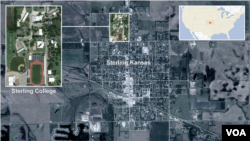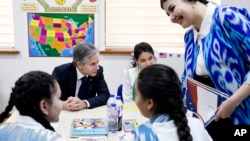Student Union
COVID Threatens Small Colleges, Small Towns

There's a lot riding on a kickoff set for 6 p.m. Saturday, Sept. 12.
The Sterling College Warriors are scheduled to take on the McPherson College Bulldogs at home. If that familiar thud of shoe against football and cheer from the stands doesn't happen, the college that keeps the central Kansas town's economy humming, that gives it cultural vitality, and that separates Sterling from the hollowing out that defines so many other small Midwestern towns, might not survive.
The school, after 133 years, could die and doom the town that takes such pride in the football squad and embraces the student body like family.
"If COVID defeats the athletic season this year, it will probably defeat a lot of small colleges," said Jeb Miller, a non-traditional senior at Sterling College. "And, as a result, harm a lot of small towns. Badly."
Hundreds of small colleges dotting the country rely on students paying tens of thousands of dollars a year in exchange for a distinctive, personal, high-touch college experience.
Many of those colleges hung on year-to-year even before the pandemic. Now COVID-19 threatens to cut off the oxygen sustaining these schools, and the sports programs that drive enrollment, KCUR-FM reports.
But the very thing small colleges need to stay afloat — students coming in, spending money, playing sports — also poses a major risk to relatively isolated little towns that, so far, have dodged major coronavirus outbreaks.
Only about 2,200 people live in Sterling out on the flat, flat plains of south-central Kansas. But this small city boasts an almost idyllic downtown. New office buildings. Two good coffee shops. A nice grocery store, a bowling alley, you name it.
Sterling has good schools, competitive sports teams. Locals say school plays, games and concerts draw big crowds. Without the college, the money, diversity and energy that defines life in Sterling could evaporate quickly.
"There is just so much overlap," said Kyler Comley, a Sterling College senior who's lived in the town all his life. "The community supports the college. The college supports the community. You know, you just see how everything's intertwined and how people are just so overly giving and involved."
Every student attending Sterling College gets paired with a family in town. Those families speak endearingly about their adopted scholars.
The students left in March. Most haven't come back. Like many people here, Sterling criminal justice professor Mark Tremaine said that starting classes up again in person this month is make or break for Sterling College.
"The bottom line is, we've got to get students back to campus. If we're going to survive," he said."We have to accept whatever the risks are and do it."
And that's the plan. Sterling doesn't have much of a choice.
"We have committed to open up in the fall," Sterling College President Scott Rich said. "With face to face classes, face-to-face coursework, dorms and activities and full swing. But we're committed to doing it safely."
Rich said the school will quarantine students coming back to the dorms, test them liberally, and isolate those who come down sick in local hotels.
Rich said the freshman class looks strong, with about 200 new students. But he is desperately trying to woo 50 or so upperclassmen who haven't signed on this year. The school needs them because, like many other small institutions, Sterling College scrapes by from year to year.
"We're always dependent upon enrollment, always dependent upon that next year, always dependent upon persistence or retention," Rich said. "We have to get students to come back."
Other small-town schools across the country, and the communities tied to their fate, face the same existential crisis.
"Some of the people I know are looking at hundreds of colleges going out of business within the next several years, if this pandemic continues and if the economic devastation associated with it continues," said Scott Carlson with the Chronicle of Higher Education.
Small liberal arts colleges have been shaky for years. Enrollments have slumped, endowments have been drained. Many schools have piled on debt in a building boom fueled by competition for students.
Most offer courses online, but online classes don't pay the bills. Small schools survive only by providing an expensive, in-person college experience. And Carlson said the pandemic shreds that business model, and threatens to trigger the higher education equivalent of a mass extinction.
"It's kind of sad," he said. "These colleges are unique, little entities all on their own, and each one of them provides a unique spin on higher education."
Sterling College, for instance, leans heavily on a particular interpretation of Christianity. Guarding the front door of the classic, old limestone building that anchors campus is a statue of Christ — not being tortured on the cross, but humbly washing the feet of a disciple. "Servant leadership," as anyone here will tell you, guides the campus ethic.
But Jesus doesn't keep the lights on here. Football does.
"We do have a good football team," said Sterling's athletic director, Scott Downing. "They've been fairly successful the last dozen years and been to the national playoffs, won the conference championship."
The team helps bring the students together, but more importantly, it drives enrollment.
"With a football team number of about 125 to 135 student-athletes, quite a bit of our student body is involved in that sport," Downing said.
That's an understatement. There are only about 500 students on campus in a given year, one in four is on the football team. And there are 20 other sports.
The chance to play college sports is a major selling point for schools like Sterling. It drives enrollment. But in a pandemic, sports can be vectors for disease. And Jed Miller, who's finishing his degree at Sterling online next year, says that's another vulnerability.
"If COVID defeats the athletic season this year, it will probably defeat a lot of small colleges," he said. "And as a result, hurt a lot of small towns ... badly."
So, the same colleges that keep some small towns vibrant now pose a particular threat to public health.
"The college probably is the most dangerous element for us in terms of COVID," said Kristina Darnauer, a family practice doctor in Sterling. "It potentially brings back students from all over the US who have variable levels of exposure."
Darnauer is torn. She loves Sterling, loves the college, and fully appreciates how important it is to the school and the town that college ramp almost as normal this fall.
But she's got patients to care for. And she said this county, with only one hospital and no intensive care unit is not ready for a cluster of coronavirus cases.
"If we have a huge outbreak," Darnauer said, "we're going to be out of resources very quickly."
Small colleges and college towns across much of the country face the same worries.
But some analysts say that a pruning of universities may prove inevitable, and that the coronavirus has only sped up the thinning of the higher education herd.
"I actually see the future of higher education, broadly speaking, as entering a new golden age," said Richard Price, a research fellow at the Clayton Christensen Institute. It's a think tank that presses for dramatic change in institutions.
Price said the pandemic may hasten the evolution to better online classes, and a public education system that's much more accessible and equitable.
"The traditional model, it was originally for the landed elite and it wasn't for all genders," Price said. "It wasn't for all races. And that is slowly getting phased out along with some older business models that aren't pivoting well."
And Price thinks many little colleges will adapt. Lots of them have cheated death before. But he said there's little doubt that this time next year the United States will have many fewer colleges. Folks in Sterling Kansas hope and, yes, pray, that Sterling College is among the survivors.
See all News Updates of the Day
- By VOA News
Michigan State international students get their own space

Michigan State University in East Lansing, Michigan, is setting aside a space in the International Center for international students.
Nidal Dajani, vice president of the school's International Student Association, said that the club plans to use the space to host events and hopes to collaborate with other student groups.
- By Dylan Ebs
International students find community during Pride Month

For LGBTQ+ international students, Pride Month, observed in June, is a unique time to reflect.
They hold on to multiple identities — both their LGBTQ+ identity and their cultural background — but coming to terms with them is not always easy.
For graduate student David Zhou, these identities can feel conflicting as transgender rights in China remain a controversial issue and spaces for LGBTQ people close. Zhou, 25, is transgender and pursuing an education in the STEM field at an urban university in the Midwestern United States.
VOA is using a pseudonym for Zhou’s first name and is not naming his university to protect his identity due to safety concerns back home in China. Zhou is not open about his transgender identity to his family.
During Pride Month, Zhou said he attended multiple LGBTQ+ events in his community and is surrounded by a supportive group of LGBTQ+ students who can relate to his experiences. But he’s not open about his identity to everyone on campus and said he doesn’t disclose his preferred pronouns to everyone to avoid transphobic comments.
“I feel like I have to make some judgments of the character of that person to see if they’re a good person to disclose [my identity] to,” Zhou said.
Zhou’s Pride Month celebrations included attending local markets with LGBTQ+ vendors and hanging out with his LGBTQ+ friends.
“They normalized being trans and for a long time I feel like trans identity is, should I say a vulnerability, brings me fear and worrying about discrimination, but having those events are helpful because it allowed me to see that queer people could just [live] openly,” he said.
At social events where few international students are present, Zhou said it can be tough to fit in.
“There's a lot of times like when they were talking about things I kind of, don't really understand, mostly because I kind of lack some background experience or knowledge,” he said.
Zhou said he is not aware of specific groups for LGBTQ+ international students at his university, but said international students are more prevalent in graduate programs and therefore find representation in organizations for LGBTQ+ graduate students.
In China, transgender individuals must obtain consent from an “immediate family member,” even for adults hoping to transition, which critics say limits the autonomy of transgender individuals while supporters say the policy protects doctors from violence by upset parents.
Struby Struble, a former coordinator of the University of Missouri LGBTQ+ Resource Center, told NAFSA: Association of International Educators in 2015 that LGBTQ+ international students face a “double barrier” on campus.
“With their international student friends, they feel isolated because they’re the LGBT one,” she said. “But then among the LGBT students on campus, they feel isolated because they’re the international one.”
Nick Martin, associate director of the Q Center, Binghamton University’s LGBTQ+ student support office, said when international students tour the center, there’s often a sense of hesitation as they enter a type of space that may not be present in their home country.
“I compare that to a year in after they've come into the space, they've again, maybe come to some of our events, they've got more connected,” he said.
Martin said graduate students have a unique interest in the Q Center as they may use the office for research and advocacy purposes that align with their studies.
“For older students, there may be hesitancy in a different way, but I think it's more in the vein of they want to do some of the advocacy work,” he said.
Martin said he thinks about how both his office and BU’s international student office can support students who come from countries with few — if any — protections for LGBTQ+ individuals.
“It's been a learning process of what those students really need, but I think I've kind of learned that a lot of students are just looking for the safe space that we offer,” Martin said.
- By VOA News
International students discuss US campus culture shock

International students at De Anza College in Cupertino, California, talked about culture shock in an article in La Voz News, the student newspaper.
"It felt like a major culture shock. Everything was so different, from academics to mannerism," said a student from Mexico.
Read the full story here.
These are the most expensive schools in the US

High tuition costs along with housing and food expenses can add up for students at U.S. colleges and universities.
MSNBC looked at the most expensive schools in the country, with one costing more than $500,000 for a bachelor’s degree. (June 2024)
Uzbekistan students admitted into top US universities

Students from Uzbekistan are among the international students admitted to top colleges and universities in recent years.
Gazata.uz profiled some of the Uzbekistan students attending Harvard, Brown, Princeton and other U.S. universities. (June 2024)






